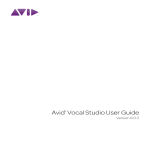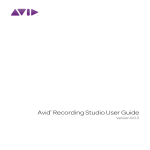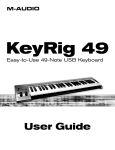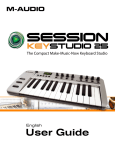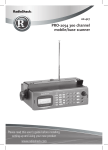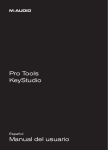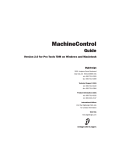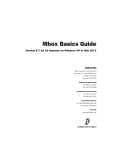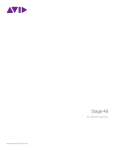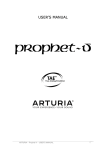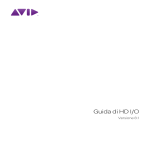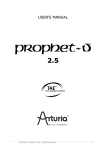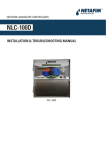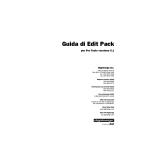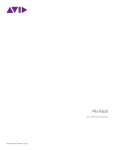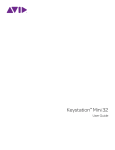Download Avid® KeyStudio - AV-iQ
Transcript
Avid KeyStudio™ User Guide ® Version 8.0.3 Legal Notices This guide is copyrighted ©2010 by Avid Technology, Inc., with all rights reserved. Under copyright laws, this guide may not be duplicated in whole or in part without the written consent of Avid Technology, Inc. Avid, Pro Tools, Pro Tools SE and M-Audio are either trademarks or registered trademarks of Avid Technology, Inc. All other trademarks contained herein are the property of their respective owners. Product features, specifications, system requirements, and availability are subject to change without notice. Guide Part Number 8420-30242-01 REV A 06/10 Documentation Feedback At Avid, we are always looking for ways to improve our documentation. If you have comments, corrections, or suggestions regarding our documentation, email us at [email protected]. contents Chapter 1. Introduction . . . . . . . . . . . . . . . . . . . . . . . . . . . . . . . . . . . . . . . . . . . . . . . . . . . . . . 1 KeyStudio Features . . . . . . . . . . . . . . . . . . . . . . . . . . . . . . . . . . . . . . . . . . . . . . . . . . . . . . . 1 System Requirements . . . . . . . . . . . . . . . . . . . . . . . . . . . . . . . . . . . . . . . . . . . . . . . . . . . . . 2 Hardware Registration . . . . . . . . . . . . . . . . . . . . . . . . . . . . . . . . . . . . . . . . . . . . . . . . . . . . . 2 Pro Tools SE Guide Set . . . . . . . . . . . . . . . . . . . . . . . . . . . . . . . . . . . . . . . . . . . . . . . . . . . . 2 Chapter 2. The KeyStudio Keyboard . . . . . . . . . . . . . . . . . . . . . . . . . . . . . . . . . . . . . . . . . . . 3 Controls and Connections. . . . . . . . . . . . . . . . . . . . . . . . . . . . . . . . . . . . . . . . . . . . . . . . . . . 3 Chapter 3. Installing KeyStudio . . . . . . . . . . . . . . . . . . . . . . . . . . . . . . . . . . . . . . . . . . . . . . . 5 Installation Overview . . . . . . . . . . . . . . . . . . . . . . . . . . . . . . . . . . . . . . . . . . . . . . . . . . . . . . 5 Mac OS X . . . . . . . . . . . . . . . . . . . . . . . . . . . . . . . . . . . . . . . . . . . . . . . . . . . . . . . . . . . . . . 5 Windows . . . . . . . . . . . . . . . . . . . . . . . . . . . . . . . . . . . . . . . . . . . . . . . . . . . . . . . . . . . . . . 6 MP3 Export Option . . . . . . . . . . . . . . . . . . . . . . . . . . . . . . . . . . . . . . . . . . . . . . . . . . . . . . . 7 Installing Your KeyStudio Keyboard. . . . . . . . . . . . . . . . . . . . . . . . . . . . . . . . . . . . . . . . . . . . 8 Hardware Connections. . . . . . . . . . . . . . . . . . . . . . . . . . . . . . . . . . . . . . . . . . . . . . . . . . . . . 8 Checking Your Signal Path . . . . . . . . . . . . . . . . . . . . . . . . . . . . . . . . . . . . . . . . . . . . . . . . . . 9 Software and System Configuration . . . . . . . . . . . . . . . . . . . . . . . . . . . . . . . . . . . . . . . . . . . 9 Chapter 4. The Software Control Panel . . . . . . . . . . . . . . . . . . . . . . . . . . . . . . . . . . . . . . . 11 Accessing the Control Panel . . . . . . . . . . . . . . . . . . . . . . . . . . . . . . . . . . . . . . . . . . . . . . . . 11 Levels Tab (All Systems) . . . . . . . . . . . . . . . . . . . . . . . . . . . . . . . . . . . . . . . . . . . . . . . . . . 11 Latency Tab (Windows) . . . . . . . . . . . . . . . . . . . . . . . . . . . . . . . . . . . . . . . . . . . . . . . . . . . 12 About Tab (All Systems) . . . . . . . . . . . . . . . . . . . . . . . . . . . . . . . . . . . . . . . . . . . . . . . . . . . 12 Chapter 5. Using KeyStudio . . . . . . . . . . . . . . . . . . . . . . . . . . . . . . . . . . . . . . . . . . . . . . . . . 13 Launching Pro Tools SE . . . . . . . . . . . . . . . . . . . . . . . . . . . . . . . . . . . . . . . . . . . . . . . . . . . 13 Recording Audio Tracks . . . . . . . . . . . . . . . . . . . . . . . . . . . . . . . . . . . . . . . . . . . . . . . . . . . 14 Recording Instrument Tracks . . . . . . . . . . . . . . . . . . . . . . . . . . . . . . . . . . . . . . . . . . . . . . . 15 Opening a Recent Session . . . . . . . . . . . . . . . . . . . . . . . . . . . . . . . . . . . . . . . . . . . . . . . . . 16 Contents iii Chapter 6. Advanced KeyStudio Keyboard Features . . . . . . . . . . . . . . . . . . . . . . . . . . . 17 Edit Mode . . . . . . . . . . . . . . . . . . . . . . . . . . . . . . . . . . . . . . . . . . . . . . . . . . . . . . . . . . . . 17 Re-Assigning KeyStudio Keyboard Buttons and Controls . . . . . . . . . . . . . . . . . . . . . . . . . . . . 18 Re-assigning the Modulation Wheel and Volume Slider . . . . . . . . . . . . . . . . . . . . . . . . . . . . 20 Additional Programming and Control Assignment Methods . . . . . . . . . . . . . . . . . . . . . . . . . 21 Chapter 7. MIDI Messages In-Depth . . . . . . . . . . . . . . . . . . . . . . . . . . . . . . . . . . . . . . . . . 25 Program & Bank Changes . . . . . . . . . . . . . . . . . . . . . . . . . . . . . . . . . . . . . . . . . . . . . . . . . 25 Chapter 8. KeyStudio Keyboard Troubleshooting . . . . . . . . . . . . . . . . . . . . . . . . . . . . . . 27 General Issues . . . . . . . . . . . . . . . . . . . . . . . . . . . . . . . . . . . . . . . . . . . . . . . . . . . . . . . . . 27 MIDI Issues . . . . . . . . . . . . . . . . . . . . . . . . . . . . . . . . . . . . . . . . . . . . . . . . . . . . . . . . . . . 29 Appendix A. General MIDI Instruments . . . . . . . . . . . . . . . . . . . . . . . . . . . . . . . . . . . . . . . 31 Appendix B. Standard MIDI Controller Numbers . . . . . . . . . . . . . . . . . . . . . . . . . . . . . . . 33 Appendix C. Additional RPN Messages . . . . . . . . . . . . . . . . . . . . . . . . . . . . . . . . . . . . . . . 35 Appendix D. Additional Information and Support . . . . . . . . . . . . . . . . . . . . . . . . . . . . . . . 37 Pro Tools SE . . . . . . . . . . . . . . . . . . . . . . . . . . . . . . . . . . . . . . . . . . . . . . . . . . . . . . . . . . 37 M-Audio Drivers . . . . . . . . . . . . . . . . . . . . . . . . . . . . . . . . . . . . . . . . . . . . . . . . . . . . . . . . 37 Before Updating Your System . . . . . . . . . . . . . . . . . . . . . . . . . . . . . . . . . . . . . . . . . . . . . . 37 Appendix E. Compliance Information . . . . . . . . . . . . . . . . . . . . . . . . . . . . . . . . . . . . . . . . . 39 Environmental Compliance . . . . . . . . . . . . . . . . . . . . . . . . . . . . . . . . . . . . . . . . . . . . . . . . 39 EMC (Electromagnetic Compliance) . . . . . . . . . . . . . . . . . . . . . . . . . . . . . . . . . . . . . . . . . . 40 Safety Compliance . . . . . . . . . . . . . . . . . . . . . . . . . . . . . . . . . . . . . . . . . . . . . . . . . . . . . . 40 iv Avid KeyStudio User Guide chapter 1 Introduction Welcome to Avid® KeyStudio™. KeyStudio turns your Mac or PC into a complete recording and music production environment, by combining a velocity sensitive 49-key keyboard, a high-performance, low-latency USB audio interface and Pro Tools® SE from Avid®. Pro Tools is the industry standard platform in music production software that is used in top recording facilities around the world. Whether you're new to music production or a seasoned professional wanting to take Pro Tools SE on the road, this package includes what you need for a professional-quality recording setup. Please take the time to read this User Guide. It will explain how to get the best results out of your KeyStudio. KeyStudio Features M-Audio KeyStudio Keyboard • 49-key velocity-sensitive keyboard • Pitch Bend wheel • Modulation wheel; MIDI re-assignable • Edit Mode button for advanced functions and programming • Sustain pedal input • No driver required; Connect and power on • USB powered M-Audio USB Micro Audio Interface • Low latency performance • 1/8-inch mono/stereo input for instrument, microphone, and line-level devices • 1/8-inch stereo output for headphones or powered monitors • USB Powered Pro Tools SE Music Production Software Chapter 1: Introduction 1 System Requirements Minimum System Requirements can be found on the Avid website at www.avid.com/support. A qualified version of Adobe® Flash® Player is required. Conventions Used in This Guide The following symbols are used to highlight important information: The following symbols are used to highlight important information: User Tips are helpful hints for getting the most from your system. Hardware Registration Please take the time to register your product online at www.avid.com/support. By doing so, you become eligible to receive the following: Important Notices include information that could affect your data or the performance of your system. • Technical support information • Software update and upgrade notices • Hardware warranty information Pro Tools SE Guide Set Complete documentation can be accessed from the Help Menu. Interactive Guides and Tutorials Interactive guides and tutorials can be accessed via the Pro Tools SE Quick Start dialog or the Help Menu while the program is running. 2 Avid KeyStudio User Guide Cross References point to related sections in this guide and other Avid guides. chapter 2 The KeyStudio Keyboard Controls and Connections Sustain 7 9 8 6 5 4 3 2 1 Figure 1. M-Audio KeyStudio Your M-Audio KeyStudio is a 49-note full-size, velocity sensitive USB MIDI controller keyboard designed for easy integration with your Mac or PC. KeyStudio offers the functions and features as listed below: 1 Modulation Wheel This wheel lets you add vibrato to notes you play. It can be assigned to control other instrument parameters as described in Chapter 6, “Advanced KeyStudio Keyboard Features.” 2 Pitch Bend Wheel This wheel is used to bend the notes played up or down. The amount of pitch change is determined by the instrument preset for the sound you are playing. Chapter 2: The KeyStudio Keyboard 3 3 Octave Buttons These Octave buttons let you shift the keyboard up or down in one octave increments. The tuning can be lowered to a maximum of three octaves, or raised as high as four octaves. When the keyboard is set to the default octave (zero), the LED’s above each button are illuminated. Pressing the Octave “>” button once switches of the LED above the Octave “<” button, indicating the keyboard is tuned an octave higher. For example, this results in note F3 becoming F4. Pressing the Octave “<” button once switches of the LED above the Octave “>” button, indicating the keyboard is tuned an octave lower. For example, this results in note F3 becoming F2. Simultaneously pressing the “<“ and “>” buttons returns the keyboard to the default octave (0). When used in conjunction with the Edit button, the Octave buttons let you use additional functions such as Transpose. See “Re-Assigning KeyStudio Keyboard Buttons and Controls” on page 18. 4 Volume Slider By default, this slider lets you control the output level of the software instrument you are playing. It can also be reassigned to control other parameters as described in Chapter 6, “Advanced KeyStudio Keyboard Features.” 5 Edit Mode Button Pressing this button switches the keyboard to Edit mode which lets you access additional keyboard functions as described in Chapter 6, “Advanced KeyStudio Keyboard Features.” 4 Avid KeyStudio User Guide 6 Velocity-sensitive Keyboard The velocity sensitive keyboard sends Note On/ Off and Velocity data to software instruments when performing. Each note is labeled with its corresponding note or pitch. The keyboard also lets you access extended programing functions as described in Chapter 6, “Advanced KeyStudio Keyboard Features.” 7 USB Port This port is used when connecting your KeyStudio keyboard to an available USB port on your computer. This connection delivers power to the keyboard and transmits MIDI data. 8 Sustain Pedal Jack This jack lets you connect a momentary-contact foot pedal (not included). When pressed, this pedal sustain the sound you are playing when your fingers are no longer pressing the keys. The polarity of the sustain pedal is determined by the keyboard upon startup. When your KeyStudio keyboard is powering up, the sustain pedal is assumed to be in the “up” (Off) position. It is important that the sustain pedal is not pressed during startup, otherwise notes will sustain when the pedal is not pressed. 9 On/Off Switch This switch lets you power the device on (1) or off (0). When this switch is set to the “On” position, KeyStudio is powered via the USB connection to your computer. chapter 3 Installing KeyStudio This chapter shows you how to install KeyStudio on Mac OS X and Windows systems. 2 Insert the installation DVD into your com- puter. 3 When the disc opens, double-click the in- staller icon to launch the installation. Installation Overview The KeyStudio installation includes the following steps: 1 Installing Pro Tools SE. 2 Installing M-Audio USB Micro driver. 3 Connecting M-Audio USB Micro. 4 Installing your M-Audio KeyStudio keyboard. Pro Tools SE Installer Icon 5 Software configuration. 6 System configuration. 4 Click “Continue” on the Welcome screen, and follow all on-screen instructions. Mac OS X The Pro Tools SE DVD runs a two-stage installation process. Stage 1 installs Pro Tools SE, and Stage 2 installs the USB Micro Driver. It is important to carefully read and follow all on-screen instructions. To Install KeyStudio: Pro Tools SE Installer - Welcome Screen 1 Make sure your KeyStudio keyboard and USB Micro are not connected to your computer. Chapter 3: Installing KeyStudio 5 5 When the following screen appears, click “Continue” and follow the on-screen instructions. Windows The Pro Tools SE DVD runs a two-stage installation process. Stage 1 installs Pro Tool SE, and Stage 2 installs the USB Micro Drivers. It is important to carefully read and follow all on-screen instructions. To Install KeyStudio: 1 Make sure your KeyStudio keyboard and USB Micro are not connected to your computer. 2 Insert the installation DVD into your com- Click Continue Software instrument content is very large and may take up to 30 minutes to install. During this time, the progress bar may not appear to move but your software is still installing. Do not terminate your installation. puter. In Windows 7, if the User Account Control dialog appears, click “Allow.” If the Welcome screen doesn’t appear, locate and double-click Setup.exe. 6 Choose the picture of USB Micro on the next screen, click “Continue” and follow the onscreen instructions to install the USB Micro driver. Pro Tools SE Installer - Welcome Screen 3 Click “Continue” to install Pro Tools SE. Driver Selection - USB Micro 7 Once the installation is complete and your computer has been restarted, connect USB Micro to an available USB port on your computer. 6 Avid KeyStudio User Guide Software instrument content is very large and may take up to 30 minutes to install. During this time, the progress bar may not appear to move but your software is still installing. Do not terminate your installation. 4 When the following screen appears, choose 8 Click “Finish” once the software has been the picture of USB Micro, and follow the onscreen instructions to install the USB Micro driver. installed. If the Found New Hardware Wizard reappears, repeat steps 6 through 8. If the Windows Logo Testing or “trusted application dialog appears, Click “Continue Anyway” (Windows XP) or “Install” (Windows 7). MP3 Export Option Driver Selection - USB Micro You may be notified that the driver being installed has not passed Windows Logo Testing, or asked whether the program you wish to run is a trusted application. Click “Continue Anyway” (Windows XP) or “Install” (Windows 7) to proceed with the installation. 5 Once the installation is complete and your computer has been restarted, connect USB Micro to an available USB port on your computer. Windows XP users may encounter additional dialog boxes. If so, proceed with steps 6 through 8. 6 Windows XP may ask if you want to search the The MP3 Export Option lets you create MP3 files from Pro Tools sessions when exporting a region or a Timeline selection as a new audio file. With the MP3 Export Option, the MP3 file type is available when using File > Export > Audio. Pro Tools uses the Fraunhofer codec for encoding MP3 files. Authorizing the MP3 Export Option The MP3 Export Option is a paid option and can be purchased and authorized when you export an audio file as an MP3. To authorize the MP3 Export Option using an authorization code: 1 Launch Pro Tools. 2 Open a session. Internet for a driver. Select “No, not this time” and click “Next.” 3 Click on a region or make a Timeline selection and choose File > Export > Audio. 7 If the Found New Hardware Wizard dialog ap- 4 Select Compressed MP3 as the File Type. pears, select “Install the software automatically” and click “Next.” 5 Click Export. 6 In the Pro Tools MP3 Option dialog, click Au- thorize. 7 In the Pro Tools MP3 Export Option dialog, select Manual Activation, then click Next. Chapter 3: Installing KeyStudio 7 8 In the Pro Tools MP3 Export Option dialog, deselect the Use my iLok Smart Key option, then click Next. 9 When prompted, enter your Pro Tools MP3 Export Option serial code (authorization code). 10 Click Next and follow the on-screen instruc- Sustain tions to complete the authorization process. Installing Your KeyStudio Keyboard Use the provided USB cable to connect KeyStudio to an available USB port on your computer. The USB cable not only powers the keyboard but also transmits MIDI data to your computer. Make sure that the power switch on the back of the keyboard is in the “on” (I) position. The KeyStudio keyboard is now ready for use. Windows users who plan on using the keyboard with more than one application at the same time, or simultaneously use other class-compliant USB audio devices, must download and install the latest KeyStudio driver from www.avid.com/support. Connect a sustain pedal (not included) to the sustain pedal jack on the back panel. USB Micro Audio Interface Once you have installed the USB Micro driver and connected the device to an available USB port on your computer, you will need to make the connections as described below: Connect your microphone, instrument (electric guitar or bass), or line-level source (synthesizer, CD player, DJ mixer, etc.) to the 1/8-inch input. Hardware Connections KeyStudio Keyboard Connect your KeyStudio keyboard to an available USB port on your computer and switch the unit on. 8 Avid KeyStudio User Guide Connect your headphones or powered speakers to the 1/8-inch output. Checking Your Signal Path 4 Click Audio Preview to listen to the song. If Listening to Demo Songs you want to open the song in a Pro Tools session click Choose. Listening to demo songs is an easy way to verify audio. To hear the audio from Pro Tools you will need your headphones or speakers connected to your audio interface. Whether you click Audition Preview or the play button in the open demo session, you will hear the song playing through your speakers or in your headphones. To listen to a demo song: 1 Use the Pro Tools SE icon to launch the pro- gram: • Mac Click on the Pro Tools SE icon in the Dock (or double-click the application icon in the Pro Tools folder inside the Digidesign folder). • Windows Click the Start button and locate the Pro Tools SE icon (or double-click the application icon in the Pro Tools folder inside the Digidesign folder). If you do not hear anything, check your hardware connections, and check your signal levels as explained in Chapter 4, “The Software Control Panel” then repeat step 4. Software and System Configuration Pro Tools SE automatically selects and configures M-Audio USB Micro and KeyStudio for audio and MIDI recording. Detailed information explaining how to configure your system for optimum performance can be found in the Pro Tools SE User Guide. Pro Tools SE Icon 2 Select the Demo Songs button. This important information covers both Mac OS X and Windows systems, and includes tips on hard drive configuration and maintenance. We strongly recommend reading these chapters to ensure the best performance from your Pro Tools SE system. Pro Tools SE Quick Start Dialog - Demo Songs 3 From the list of music styles, select the cate- gory you want (or select an item from a submenu). Chapter 3: Installing KeyStudio 9 10 Avid KeyStudio User Guide chapter 4 The Software Control Panel The Software Control Panel lets you adjust the input gain, monitor mix levels, output volume, and latency (Windows only). Levels Tab (All Systems) Input Gain This slider controls the level coming from the input. Settings below the center line will work well with line-level devices such as electronic keyboards or CD players as well as with instruments like electric guitars or basses. Settings above this line will work for most handheld and PC desk microphones (dynamic and electret microphones) Monitor Mix This slider controls the signal level from the input, that is sent directly back to the output of USB Micro. The signal is mixed with the output signal from Pro Tools SE. Accessing the Control Panel Mac OS X The USB Micro Control Panel can be found in System Preferences, under “Other.” Windows Double-click the M-Audio logo located in the system tray, generally located at the bottom right of your Windows desktop. This monitoring method is called “Hardware Monitoring” and lets you hear the input signal before any software audio processing takes place. Hardware Monitoring prevents undesirable delays which are common when monitoring your input signal through your software. Adjust this slider until you have achieved the desired balance between input and playback levels The Monitor Mix Control has no effect on what is actually recorded in Pro Tools SE. Output Volume This slider controls the level of output signal from USB Micro. Chapter 4: The Software Control Panel 11 Latency Tab (Windows) About Tab (All Systems) Latency is the time it takes for an input signal to pass through your recording software and appear at the outputs. This latency can result in a delay when overdubbing to existing tracks. This page contains information about your hardware and current driver versions. These details are helpful should you ever have to contact technical support. Clicking the links takes you to useful pages on the Avid website. This slider lets you control the amount of latency by adjust the buffer size in units of samples. The default buffer size is 256 samples. Smaller buffer sizes result in lower latency, but may cause clicks, pops and dropouts on slowersystems. If you are experiencing clicks and pops in your recording, try increasing the buffer size. To adjust the buffer size in Pro Tools SE, choose File > Preferences to open the Preferences dialog, then choose the Audio page. This lets you choose one of the two radio buttons in the lower half of the dialog. Refer to the Pro Tools SE User Guide for more information about setting the buffer size and other important settings when configuring Pro Tools SE. Mac OS X In Mac OS X, the buffer size is adjusted within Pro Tools SE by choosing the File Menu > Preferences to open the Preferences dialog, then choose the Audio page. This lets you choose one of the two radio buttons in the lower half of the dialog. Refer to the Pro Tools SE User Guide for more information about setting the buffer size and other important settings when configuring Pro Tools SE. 12 Avid KeyStudio User Guide chapter 5 Using KeyStudio Launching Pro Tools SE The first step in beginning a Pro Tools project is working with a session. Pro Tools provides a Quick Start dialog on launch that lets you quickly and easily work with session templates, listen to demo songs and view tutorials. • Open any other session on your system. • Open and view tutorials. The Pro Tools SE tutorials can be accessed via the Help menu at any time. Creating a Session From a Template To launch Pro Tools SE and open a session: To create a new session from a template: 1 Use the Pro Tools SE icon to launch the pro- gram: 1 Select the New Session button. • Mac Click on the Pro Tools SE icon in the Dock (or double-click the icon in the Pro Tools folder inside the Digidesign folder). • Windows Click the Start button and locate the Pro Tools SE icon (or double-click the icon in the Pro Tools folder inside the Digidesign folder). Pro Tools SE Quick Start Dialog - New Session Pro Tools SE Icon 2 Use the Quick Start dialog to do one of the following: • Create a session from templates. • Listen to demo songs (lets you verify sound). See “Checking Your Signal Path” on page 9. 2 Select any session template from the list. 3 Click Choose to open the template. 4 In the Save As dialog, name the session, choose where you want to save the session, and click Save. Chapter 5: Using KeyStudio 13 Recording Audio Tracks This section shows you how to record an audio track in Pro Tools SE. 6 Switch the track to record mode by clicking its Record Enable button. While the track is record enabled, the button and the track fader will be red. To record an audio track: 1 On the Levels tab of the Software Control Panel, turn the Input Gain Control all the way down. 2 Connect an instrument or microphone to the Track Record Enable Button and Fader in Record Mode input of your USB Micro interface. 7 Sing, or play an instrument into the USB Mi3 Choose an Audio track by clicking on an ap- propriate track name, such as “Audio 1” on the left side of the Pro Tools SE Edit window. To create a track, go to the Track menu, click Track > New and choose Audio track. cro (at the loudest level you expect to occur during your recording) while slowly increasing the Input Gain in the Software control Panel, until the level meter for the track is in the red. Raising or lowering the Track fader will not affect the input level, as it only controls the track playback volume. 8 While continuing to sing or play, lower the Input Gain in the Software Control Panel, and stop at the point where the level meter is no longer in the red. Audio Track 4 Click on the Input Selector (In) to the left of the track name, and choose “Input 1” as the input source. Input Selector 5 Click the Mute button for the track to prevent it from sending the input signal to the output of USB Micro. Track Mute Button 14 Avid KeyStudio User Guide 9 In the Software Control Panel, increase the Monitor Mix Level to a suitable volume so that you can hear the input signal. This is especially useful when recording in a session with pre-recorded tracks, because it lets you adjust the balance between the existing tracks and your input signal. When recording with a microphone while monitoring with speakers, you should turn the Output Gain all the way down in the Software Control Panel. This prevents the microphone from picking up the output from Pro Tools SE if the microphone is in the same room as your speakers. Placing a microphone too close to your speakers with the Output Gain set to high levels will result in feedback which could seriously damage your hearing and/or equipment. 10 Using the on-screen transport controls, Re- cord Arm Pro Tools SE by clicking the Record button. Recording Instrument Tracks This section shows you how to record a software instrument track in Pro Tools SE. Further information can be found in the Pro Tools SE Interactive Projects Guide, which is accessed via the Help Menu. To record an instrument track: 1 Choose an instrument track by clicking on an Record Button appropriate track name, such as “Inst 2” on the left side of the Pro Tools SE Edit window. 11 Begin recording your performance by click- ing the Play button. Play Button Instrument Track 12 Click the Stop button in the transport win- dow when you have finished recording your performance. Stop Button 13 Press the Record Enable button to take the To create a track, go to the Track menu, click Track > New and choose Instrument track. 2 If the Instrument Selector for the track says “No Instrument,” click on it and choose one of the software instruments. track out of record mode. 14 Press the Mute button for the track, so that you can hear your recording during playback. Instrument Selector Do not forget to save your work. When notes are played on your KeyStudio keyboard you will hear the sound of the currently loaded instrument. Chapter 5: Using KeyStudio 15 3 Switch the track to record mode by clicking its Record Enable button. While the track is record enabled, the button and the track fader will be red. Opening a Recent Session To open a recent session: 1 Launch Pro Tools SE. 2 When the Pro Tools SE Quick Start dialog ap- pears click the Open Session button. Track Record Enable Button and Fader in Record Mode 4 Using the on-screen transport controls, Re- cord Arm Pro Tools SE by clicking the Record button. Record Button 5 Begin recording your performance by clicking the Play button. Pro Tools SE Quick Start Dialog - Open Session 3 From the list of recent session templates, se- lect the one you want. (Or, select Open Other... to select other recent sessions.) Play Button 6 Click the Stop button when you have finished recording. Stop Button 7 Switch the track out of record mode by click- ing its Record Enable button. Do not forget to save your work. 8 Click the Play button to hear your recording. 16 Avid KeyStudio User Guide 4 Click to open the session. chapter 6 Advanced KeyStudio Keyboard Features Edit Mode The Edit Mode Button When you press the Edit Mode button (seeChapter 2, “The KeyStudio Keyboard”), the LED above it will illuminate and your KeyStudio keyboard is switched to Edit mode. Edit mode lets you access control assignment and advanced programming features using the secondary key functions shown in the illustration below. The keyboard is switched back to Performance mode whenever the “Cancel” or “Enter” key is pressed. However there are certain operations which take effect instantly and do not require using the “Enter” key to confirm your changes. In these cases, KeyStudio will revert to Performance mode as soon and you enter the parameter assignment or value. The LED above the button will be switched off as soon as the keyboard is taken out of Edit mode. KeyStudio Keyboard - Advanced Functions Chapter 6: Advanced KeyStudio Keyboard Features 17 Re-Assigning KeyStudio Keyboard Buttons and Controls This section shows you how to assign the Octave buttons, Modulation wheel, and Volume slider to control different software instrument functions and parameters within Pro Tools SE. The Octave Buttons While KeyStudio is in Edit mode, these buttons can be assigned to the following functions: • Octave Shift • Transpose • Program change • Bank LSB • Bank MSB • MIDI Channel Change Turning off your KeyStudio keyboard resets the Octave buttons, and they will revert to their default function when it is powered up again. Octave Shift Although Octave shift is the default function for these buttons, they will need to be re-assigned if they have been assigned to perform any of the other five functions as described below in this section. To assign the Octave “<” and “>” buttons to control Octave shift: 1 Press the Edit Mode button. 2 Choose the Octave shift function by pressing the “DATA = OCTAVE” key (C#1). Your KeyStudio keyboard will exit Edit Mode as soon as C#1 is pressed and the Octave buttons will function as described in Chapter 2, “The KeyStudio Keyboard.” Transpose Assigning the Octave Shift buttons to the Transpose function lets you raise or lower the keyboard one half-step (semi tone) at a time. In Transpose mode, pressing the Octave “>” button transposes note F3 to F#3. Pressing the Octave “<” button transposes note F3 down a half-step to E3). Simultaneously pressing the “<“ and “>” buttons returns the keyboard to the default transposition value(0). 18 Avid KeyStudio User Guide To assign the Octave buttons to the Transpose function: 1 Press the Edit Mode button. 2 Choose the Transpose function by pressing the “DATA = TRANSPOSE” key (D#1). MIDI Channel Change When ever you play notes or move one of the controls on your KeyStudio keyboard, it transmits MIDI data to your computer on MIDI channel 1 by default. Assigning the Octave Shift buttons to the MIDI Channel function lets you change the MIDI channel to any of the other 15 channels. For example, this is useful if you’re controlling a General MIDI instrument that only receives MIDI information on channel 10. In MIDI Channel mode, pressing the Octave “>” button lets you step upward through the channel number, while pressing the Octave “<” button steps downward. Simultaneously pressing the “<“ and “>” buttons sets the keyboard to the default MIDI channel (1). To assign the Octave buttons to the MIDI Channel function: 1 Press the Edit Mode button. 2 Choose the MIDI Channel function by pressing the “DATA = CHANNEL” key (C#2). Program Change Assigning the Octave Shift buttons to the Program Change function lets you step through and choose sound presets within a software instrument in Pro Tools SE. In Program Change mode, pressing the Octave “>” button lets you step upward through the presets number, while pressing the Octave “<” button steps downward. Simultaneously pressing the “<“ and “>” buttons selects the default Program number (0). To assign the Octave buttons to the Program Change function: 1 Press the Edit Mode button. 2 Choose the MIDI Channel function by pressing the “DATA = PROGRAM” key (F#1). Chapter 6: Advanced KeyStudio Keyboard Features 19 Bank LSB and Bank Change Program Change is the most common message for choosing instrument presets. However, the number of presets accessible using only the program change MIDI command is limited to 128. Since some instruments have more than128 presets, they require a method to organize them into banks. In this case a Bank LSB (Least Significant Byte) or Bank MSB Change (Most Significant Byte) change message must be sent to access the bank containing the sound you wish to play. Once this has happened you will need to use a Program Change message to load the preset. Assigning the Octave Shift buttons to the Bank LSB or Bank MSB Change function lets you step through and choose banks of preset using either the Octave “>” or Octave “<” buttons. In either Bank LSB or Bank MSB mode, pressing the Octave “>” button lets you step upward through the bank numbers, while pressing the Octave “<” button steps downward. Simultaneously pressing the “<“ and “>” buttons selects the default Bank number (0). Once the Bank LSB or Bank MSB message has been sent, you must use the Program change function to select a sound preset from the bank. Refer to Chapter 7, “MIDI Messages In-Depth” for more information about Bank LSB and Bank MSB messages. To assign the Octave buttons to the Bank LSB or Bank MSB function: 1 Press the Edit Mode button. 2 Choose either Bank LSB function by pressing the “DATA = BANK LSB” key (G#4), or Bank MSB by pressing the “DATA = BANK MSB” key (A#4). Re-assigning the Modulation Wheel and Volume Slider These Controls can be assigned to various instrument functions by “linking” them to a new MIDI continuous controller number (MIDI CC). For example, the Volume Slider can be assigned to control the Modulation parameter of a software instrument, or the Modulation Wheel can be assigned to control the Reverb Depth (amount) parameter. To assist you with this process, a full listing of Standard MIDI CC numbers can be found in Appendix B, “Standard MIDI Controller Numbers.” Certain third party software instruments or plug-ins (such as reverbs or EQ's) may not be able to receive certain MIDI CC's. Refer to the documentation provided with these applications for in formation about their capabilities. 20 Avid KeyStudio User Guide The following example shows you how to assign the Volume Slider to the Modulation function (MIDI CC 01). However, you can substitute either control or any of the MIDI CC numbers listed in Appendix B, “Standard MIDI Controller Numbers” based on what you are trying to achieve. To assign the Volume slider to a new MIDI CC number: If you make a mistake while entering the numerical data value, press the CANCEL key (C1) before pressing the ENTER key (C5) to exit Edit mode without changing the MIDI CC. 1 Press the Edit Mode button. 2 Press the “SLIDER ASSIGN” key (D#4). 3 Enter MIDI CC number 01 (Modulation) using keys G3 – B4 (0 – 9). 4 Press the ENTER key (C5). Now the Volume slider increases and decreases the amount of modulation as it is raised or lowered. Turning off your KeyStudio keyboard resets the Modulation wheel and Volume slider, and they will revert to their default functions when it is powered up again. Additional Programming and Control Assignment Methods This section shows you how to use the secondary key functions to quickly access and use the programming features of your KeyStudio keyboard. Octave Shift If the Octave buttons are assigned to a different function, you can change the octave setting for your keyboard using the “OCTAVE -” (F#2), “OCTAVE 0” (G#2), or “OCTAVE +” (Bb2) keys. The “OCTAVE -” key lets you lower the keyboard to a maximum three octaves, while the “OCTAVE +” lets you raise the keyboard to a maximum of four octaves. The “OCTAVE 0” key lets you instantly return to the default octave setting (0). The following example shows you how to use the “OCTAVE +” key to raise the keyboard by two octaves. Chapter 6: Advanced KeyStudio Keyboard Features 21 To change the octave setting using the Octave keys: If you make a mistake, press the CANCEL key (C1) before pressing the ENTER key (C5) to exit Edit mode without making any changes. 1 Press the Edit Mode button. 2 Press the “OCTAVE +” key (Bb2) twice. 3 Press the “ENTER” key (C5). Transpose If the Octave buttons are assigned to a different function, you can change the pitch your keyboard using the “TRANSPOSE -” (F#3), “TRANSPOSE 0” (G#3), or “TRANSPOSE +” (Bb3) keys. The “TRANSPOSE -” and “TRANSPOSE +” keys lower and raise the pitch one half-step (semi tone) at a time. The “TRANSPOSE 0” key lets you instantly return to the default transpose setting (0). The following example shows you how to use the “TRANSPOSE +” key to raise the keyboard by two half-steps. To change the transpose setting using the Transpose keys: If you make a mistake, press the CANCEL key (C1) before pressing the ENTER key (C5) to exit Edit mode without making any changes. 1 Press the Edit Mode button. 2 Press the “TRANSPOSE +” key (Bb3) twice. 3 Press the “ENTER” key (C5). MIDI Channel When ever you play notes or move one of the controls on your KeyStudio keyboard, it transmits MIDI data on MIDI channel 1 by default.The ability to change the MIDI channel is useful if you’re controlling an instrument that only receives MIDI information on channel 10. The following section shows how you can enter a specific MIDI channel number using keys D1 – E3 (Channels 1 – 16). 22 Avid KeyStudio User Guide To change the MIDI Channel using the MIDI Channel keys: 1 Press the Edit Mode button. 2 Press the corresponding MIDI Channel key for the channel you want to choose. Your KeyStudio keyboard will exit Edit Mode as soon as the key is pressed. Program Change If for example, you are using a General MIDI software instrument, and know the exact instrument preset (program) you want to use, you can enter it directly using the “DATA = PROGRAM” key (F#4) and the numerical Data Entry keys G3 – B4 (0 – 9). The following example shows you how to use these keys to call up the General MIDI Cello sound (p42). A full list of General MIDI instruments and program numbers can be found in Appendix A, “General MIDI Instruments.” To choose a new instrument program using the “DATA = PROGRAM” and Data Entry keys: If you make a mistake, press the CANCEL key (C1) before pressing the ENTER key (C5) to exit Edit mode without making any changes. 1 Press the Edit Mode button. 2 Press the “DATA = PROGRAM” key (F#4). 3 Press D4 key (the number 4) then B3 key (the number 2). 4 Press the “ENTER” key (C5). A Program Change message selecting General MIDI program 42 (Cello) is sent from your keyboard as soon as the “ENTER” key is pressed. Bank LSB and Bank MSB As mentioned earlier in this chapter, Program Change is the most common message for choosing instrument presets. However, the number of presets accessible using only the program change MIDI command is limited to 128. Since some instruments have more than128 presets, they require a method to organize them into banks. In this case a Bank LSB (Least Significant Byte) or Bank MSB Change (Most Significant Byte) change message must be sent to access the bank containing the sound you wish to play. Once this has happened you will need to use a Program Change message to load the preset. Chapter 6: Advanced KeyStudio Keyboard Features 23 If you do not want to reassign the Octave buttons you can send Bank LSB or Bank MSB messages using the “DATA = BANK LSB” or “DATA = BANK MSB” key and the numerical Data Entry keys G3 – B4 (0 – 9). Once the Bank LSB or Bank MSB message has been sent, you must use the Program change function to select a sound preset from the bank. Refer to Chapter 7, “MIDI Messages In-Depth” for more information about Bank LSB and Bank MSB messages. The following example shows you how to send bank change message using either the “DATA = BANK LSB” or “DATA = BANK MSB” key. To send a bank message using the “DATA = BANK LSB” or “DATA = BANK MSB” key and Data Entry keys: If you make a mistake, press the CANCEL key (C1) before pressing the ENTER key (C5) to exit Edit mode without making any changes. 1 Press the Edit Mode button. 2 Depending on the type of bank message you wish to send, press either the “DATA = BANK LSB” key (G#1) or the “DATA = BANK MSB” key (A#1). 3 Press the C4 key (the number 3) then the A3 key (the number 1). 4 Press the “ENTER” key (C5). The change message selecting bank 31 is sent from your keyboard as soon as the “ENTER” key is pressed. 24 Avid KeyStudio User Guide chapter 7 MIDI Messages In-Depth Program & Bank Changes When the MIDI standard was first established, it enabled the user to access only 128 different sounds using program change messages (0-127). As MIDI devices grew to be more sophisticated and contain more sounds, bank change messages were included in an updated MIDI specification to allow for more than 128 sounds to be accessed. The language MIDI uses to communicate between musical instruments only allows for program change commands 0-127, for a total of 128 possible programs (127 programs + program “0” = 128 programs total). Because of inherent limitations of the MIDI communication protocol, the number of directly accessible programs (using program change messages) cannot easily be expanded beyond 128. Because of this, a system of banks, with 128 sounds in Bank MSB Bank LSB Program each, has been created that enables manufacturers to Program 0 Program 1 overcome the 128-sound MIDI limit. Program 2 128 banks with 128 sounds in each bank is the basic principle used to expand the number of accessible sounds. However, to avoid reaching the new limit of the resulting 16,384 possible sounds (128 banks x 128 programs) accessible using a bank change combined with a program change, another layer of banks was added. The result is a system of 128 banks that can contain 128 subbanks in each of them, which, in turn, can contain 128 sounds (programs) within them. Bank change messages are useful when calling up sounds from a large library that may exist in a particular sound module or software synth. For example devices that are built with Roland’s GS specification or Yamaha’s XG specification require you to specify a bank change in order to access the extra voices and effects that these devices provide. Bank MSB 0 Bank LSB 0 Program 127 Bank LSB 1 Program 0 Program 1 Program 2 Bank LSB 2 Program 127 Bank LSB 127 Program 0 Program 1 Program 2 Program 127 Program 0 Program 1 Program 2 Bank MSB 1 Bank LSB 0 Program 127 Bank LSB 1 Program 0 Program 1 Program 2 Bank LSB 2 Program 127 Bank LSB 127 Program 0 Program 1 Program 2 Program 127 Program 0 Program 1 Program 2 Bank MSB 2 Bank MSB 127 Bank LSB 0 Program 127 Bank LSB 1 Program 0 Program 1 Program 2 Bank LSB 2 Program 127 Bank LSB 127 Program 0 Program 1 Program 2 Program 127 Chapter 7: MIDI Messages In-Depth 25 MIDI CC 0 is the bank select MSB (Most Significant Byte) message. This MIDI message is 7-bit in size and can be used to select any of 128 banks. This message can be used in conjunction with MIDI CC32 which is bank select LSB (Least Significant Byte): a separate 7-bit message allowing additional selection of any of another 128 sub-banks. The combination of Bank MSB and LSB messages gives a 14-bit message that can select any of a possible 16,384 banks. Each bank can in turn contain 128 possible sounds selected via a separate program change MIDI message. This enables a user to theoretically recall over two million programs directly, using only MIDI commands. However, most devices only use a few different banks, and allow you to access them with either a Bank LSB message or a Bank MSB message. Please consult your synthesizer’s or software’s documentation for more information on which type of bank change messages it can process. You will find many MIDI devices respond to program change commands and many are organized according to the GM listing. In General MIDI devices, different sounds are organized in the same way from device to device. Piano sounds are in their particular place, string sounds are in their place, drum sounds are in their place, and so on. All GM devices (both hardware and software sound modules) are clearly labeled as such, so you know that their sounds are organized in the General MIDI structure. When a GM device receives a MIDI program change, it calls up a type of sound that you expect from the GM sound set. All non-GM MIDI sound modules call up unique sounds from their memory upon receiving MIDI program changes. Since the sounds in a non-GM device are not arranged in a particular order, you need to take a look at the device itself to see which sound you want and at which location in the memory it resides. Many VST instruments such as Native Instruments’ FM7 or the synth modules in Propellerhead Reason are non-GM devices. NRPN/RPNs Non-registered parameter numbers (NRPN’s) are device-specific messages that enable you to control synths and sound modules via MIDI. The MIDI specification defines open parameter numbers to allow manufacturers to specify their own controllers. The more common of these are registered by the MIDI Manufacturer’s Association and are now part of the MIDI specification (hence the term Registered Parameter Numbers – RPN’s). (See Appendix C, “Additional RPN Messages.”) Each NRPN/RPN has an associated 2-byte number. The two bytes allow for 128 values each. (An RPN or NRPN message is made up of two parts: the MSB and the LSB message. Both of these messages together constitute an RPN or NRPN command.) This allows for 16,384 values in total. MIDI controllers 98 and 99 represent the NRPN LSB and MSB respectively, while 100 and 101 represent the RPN LSB and MSB messages (see Appendix B) To transmit an NRPN/RPN message, these LSB and MSB controller messages are sent along with their user-specified values. A further controller message and value needs to be sent to specify the (coarse or fine) value adjustment. This is specified by controller number 6 (data entry) for coarse adjustments or number 38 for fine adjustments. A list of NRPN’s is usually given in the user’s manual of any device that receives NRPN messages. It is always necessary that the NRPN MSB and LSB be sent together. Both will be specified in the device’s manual. 26 Avid KeyStudio User Guide chapter 8 KeyStudio Keyboard Troubleshooting General Issues Your KeyStudio keyboard has been tested in a wide range of systems and operating conditions. However, there are virtually limitless numbers of operating scenarios which could affect your system’s performance. Although this section cannot cover all possible situations, we would like to offer some suggestions for dealing with possible issues. If you are still not able to an answer, please refer to the Avid website at www.avid.com/support for further assistance. My KeyStudio keyboard suddenly stops working. Try a different USB Cable and/or USB port. If the keyboard still doesn’t work, close any music applications you are using, switch off your KeyStudio keyboard, and restart your computer. Once your computer has completely restarted, switch the keyboard back on. The sustain pedal works in reverse. Because the polarity of the sustain pedal is calculated by the keyboard when it is powered up, please make sure that pressure is not being applied to the pedal while your KeyStudio keyboard is powering up. Switch off the keyboard and switch it on again while making sure that pressure is not being applied to the sustain pedal. Also check to see if there is a polarity switch on your foot pedal. It is possible to use this switch to change foot pedal polarity as well. My KeyStudio keyboard will not play my software instruments. Make sure your KeyStudio keyboard is selected as the MIDI input device within Pro Tools SE. My keyboard is not listed in the Pro Tools SE MIDI devices dialog. Your KeyStudio keyboard requires a powered USB port. Try plugging it into a different USB port or a powered USB hub connected to your computer. Chapter 8: KeyStudio Keyboard Troubleshooting 27 My software instrument loads the preset next to the one I want to play. For example, i want to use preset 40 (Violin), but my software instrument loads preset 41 (Viola). Some General MIDI instruments count their presets from 1 – 128 instead of 0-127. Both methods are common. As a result, there may be an offset of +/-1 between the program change number (preset number) sent from your keyboard and the preset that the instrument loads. I cannot use two or more MIDI software applications simultaneously. My KeyStudio keyboard is only recognized by one of them. If you are planning to use your KeyStudio keyboard with more than one MIDI software application at the same time, you will need to download the latest KeyStudio keyboard driver from www.avid.com/support and install it. To install the KeyStudio keyboard driver: 1 Download the installer from www.avid.com/support. 2 Make sure your KeyStudio keyboard is not connected to your computer. 3 Locate and double-click on the installer icon, then carefully follow the on-screen instructions. 4 when the installation process is complete, connect your keyboard to a USB port on your computer. My KeyStudio keyboard listed as a MIDI input device in Windows. If your KeyStudio keyboard is being used as a class compliant device (without installing the driver), it will be listed as “USB Audio Device.” If you want your keyboard to be listed as “KeyStudio,” please download and install KeyStudio keyboard driver using the instructions in the previous topic. 28 Avid KeyStudio User Guide MIDI Issues This section shows you how to resolve two issues which may come up while using your KeyStudio keyboard, using the secondary functions of the keyboard. For a complete list of secondary key functions, refer to the illustration at the beginning of Chapter 6, “Advanced KeyStudio Keyboard Features.” Stuck MIDI Notes If you experience an issue where MIDI notes continue to sustain after you have stopped playing the keyboard and the sustain pedal is not being pressed, you can resolve this by sending an “All Notes Off” MIDI message. To send an “All Notes Off” message from your KeyStudio keyboard: 1 Press the Edit Mode button. 2 Press the “ALL NOTES OFF” key (D#3). Your KeyStudio will exit Edit mode as soon as the D#3 key is pressed and the stuck notes will stop playing. Unexpected Instrument Sounds If one or more instrument presets do not sound as expected, it may mean a MIDI CC has applied an undesired effect or other type of sound modulation. If you are unsure which MIDI controller should be used to resolve this, you can send a “Reset All Controllers” MIDI message which resets all controller to their default values. To send an “Reset All Controllers” message from your KeyStudio keyboard: 1 Press the Edit Mode button. 2 Press the “RESET ALL CONTROLLERS” key (C#3). Your KeyStudio will exit Edit mode as soon as the C#3 key is pressed and all controllers will have been reset to their default values. Chapter 8: KeyStudio Keyboard Troubleshooting 29 30 Avid KeyStudio User Guide appendix a General MIDI Instruments The following table lists General MIDI preset numbers and their names, and is provided as a reference for when you are using your Keyboard to control General MIDI instruments. Piano 0 Acoustic Grand Piano 1 Bright Acoustic Piano 2 Electric Grand Piano 3 Honky Tonk Piano 4 Electric Piano 1 5 Electric Piano 2 6 Harpsichord 7 Clavinet Bass 32 Acoustic Bass 33 Electric Fingered Bass 34 Electric Picked Bass 35 Fretless Bass 36 Slap Bass 1 37 Slap Bass 2 38 Syn Bass 1 39 Syn Bass 2 Reed 64 Soprano Sax 65 Alto Sax 66 Tenor Sax 67 Baritone Sax 68 Oboe 69 English Horn 70 Bassoon 71 Clarinet Synth Effects 96 SFX Rain 97 SFX Soundtrack 98 SFX Crystal 99 SFX Atmosphere 100 SFX Brightness 101 SFX Goblins 102 SFX Echoes 103 SFX Sci- Fi Chromatic Percussion 8 Celesta 9 Glockenspiel 10 Music Box 11 Vibraphone 12 Marimba 13 Xylophone 14 Tubular bells 15 Dulcimer Strings/ Orchestra 40 Violin 41 Viola 42 Cello 43 Contrabass 44 Tremolo Strings 45 Pizzicato Strings 46 Orchestral Harp 47 Timpani Pipe 72 Piccolo 73 Flute 74 Recorder 75 Pan Flute 76 Bottle Blow 77 Shakuhachi 78 Whistle 79 Ocarina Ethnic 104 Sitar 105 Banjo 106 Shamisen 107 Koto 108 Kalimba 109 Bag Pipe 110 Fiddle 111 Shanai Organ 16 Drawbar Organ 17 Percussive Organ 18 Rock Organ 19 Church Organ 20 Reed Organ 21 Accordion 22 Harmonica 23 Tango Accordion Ensemble 48 String Ensemble 1 49 String Ensemble 2 (Slow) 50 Syn Strings 1 51 Syn Strings 2 52 Choir Aahs 53 Voice Oohs 54 Syn Choir 55 Orchestral Hit Synth Lead 80 Syn Square Wave 81 Syn Sawtooth Wave 82 Syn Calliope 83 Syn Chiff 84 Syn Charang 85 Syn Voice 86 Syn Fifths Sawtooth Wave 87 Syn Brass & Lead Percussive 112 Tinkle Bell 113 Agogo 114 Steel Drums 115 Woodblock 116 Taiko Drum 117 Melodic Tom 118 Syn Drum 119 Reverse Cymbal Guitar 24 Nylon Acoustic 25 Steel Acoustic 26 Jazz Electric 27 Clean Electric 28 Muted Electric 29 Overdrive 30 Distorted 31 Harmonics Brass 56 Trumpet 57 Trombone 58 Tuba 59 Muted Trumpet 60 French Horn 61 Brass Section 62 Syn Brass 1 63 Syn Brass 2 Synth Pad 88 New Age Syn Pad 89 Warm Syn Pad 90 Polysynth Syn Pad 91 Choir Syn Pad 92 Bowed Syn Pad 93 Metal Syn Pad 94 Halo Syn Pad 95 Sweep Syn Pad Sound Effects 120 Guitar Fret Noise 121 Breath Noise 122 Seashore 123 Bird Tweet 124 Telephone Ring 125 Helicopter 126 Applause 127 Gun Shot Appendix A: General MIDI Instruments 31 Because some instruments count their presets from 1 – 128, there may be an offset of -1 between the program change number (preset number) sent by your keyboard and the preset that is loaded. 32 Avid KeyStudio User Guide appendix b Standard MIDI Controller Numbers The following table lists all standard MIDI Controller (MIDI CC) numbers and their names. 00 01 02 03 04 05 06 07 08 09 10 11 12 13 14 15 16 17 18 19 20 21 22 23 24 25 26 27 28 29 30 31 32 33 34 35 36 37 38 39 Bank Select Modulation Breath Control Controller 3 Foot Control Porta Time Data Entry Channel Volume Balance Controller 9 Pan Expression Effects Controller 1 Effects Controller 2 Controller 14 Controller 15 Gen Purpose 1 Gen Purpose 2 Gen Purpose 3 Gen Purpose 4 Controller 20 Controller 21 Controller 22 Controller 23 Controller 24 Controller 25 Controller 26 Controller 27 Controller 28 Controller 29 Controller 30 Controller 31 Bank Select LSB Modulation LSB Breath Control LSB Controller 35 Foot Control LSB Porta Time LSB Data Entry LSB Channel Volume LSB 40 41 42 43 44 45 46 47 48 49 50 51 52 53 54 55 56 57 58 59 60 61 62 63 64 65 66 67 68 69 70 71 72 73 74 75 76 77 78 79 Balance LSB Controller 41 Pan LSB Expression LSB Controller 44 Controller 45 Controller 46 Controller 47 Gen Purpose 1 LSB Gen Purpose 2 LSB Gen Purpose 3 LSB Gen Purpose 4 LSB Controller 52 Controller 53 Controller 54 Controller 55 Controller 56 Controller 57 Controller 58 Controller 59 Controller 60 Controller 61 Controller 62 Controller 63 Sustain Pedal Portamento Sostenuto Soft Pedal Legato Pedal Hold 2 Sound Variation Resonance Release Time Attack Time Cut- off Frequency Controller 75 Controller 76 Controller 77 Controller 78 Controller 79 80 Gen Purpose 5 81 Gen Purpose 6 82 Gen Purpose 7 83 Gen Purpose 8 84 Portamento Control 85 Controller 85 86 Controller 86 87 Controller 87 88 Controller 88 89 Controller 89 90 Controller 90 91 Reverb Depth 92 Tremolo Depth 93 Chorus Depth 94 Celeste (De- tune) 95 Phaser Depth 96 Data Increment 97 Data Decrement 98 Non- Reg Param LSB 99 Non- Reg Param MSB 100 Reg Param LSB 101 Reg Param MSB 102 Controller 102 103 Controller 103 104 Controller 104 105 Controller 105 106 Controller 106 107 Controller 107 108 Controller 108 109 Controller 109 110 Controller 110 111 Controller 111 112 Controller 112 113 Controller 113 114 Controller 114 115 Controller 115 116 Controller 116 117 Controller 117 118 Controller 118 119 Controller 119 Channel Messages: 120 All Sound off 121 Reset all Controllers 122 Local Control 123 All Notes Off 124 Omni Off 125 Omni On 126 Mono On (Poly Off) 127 Poly On (Mono Off) Extra RPN Messages: 128 Pitch Bend sensitivity 129 Fine Tune 130 Coarse Tune 131 Channel Pressure Appendix B: Standard MIDI Controller Numbers 33 34 Avid KeyStudio User Guide appendix c Additional RPN Messages You may have noticed that although we have stated there are 128 MIDI controller messages (0 – 127), Appendix B shows 132. This is because messages 128 – 131 are a different type of MIDI message, defined in the MIDI Specification as RPN messages. We have created four messages that are sent like MIDI CC's, but actually transmit a series of RPN messages. This makes sending these complex multipart messages as easy as sending a MIDI CC message. You can assign these to the controls on your KeyStudio keyboard in exactly the same way as any other MIDI controller message. The following table lists the RPN messages and what they are used for: Controller Number MIDI Message Use 128 Pitch Bend Sensitivity Alters the range of a pitch bend message 129 Master Tune (coarse) Adjusts instrument tuning in large steps 130 Master Tune (fine) Adjusts instrument tuning in small steps 131 Monophonic Aftertouch Adds vibrato to an instrument preset Monophonic aftertouch is not an RPN message. However, it is an additional effect message defined in the General MIDI specification and this is why we have included it in Appendix C. Appendix C: Additional RPN Messages 35 36 Avid KeyStudio User Guide appendix d Additional Information and Support Pro Tools SE Before Updating Your System Complete documentation for Pro Tools SE can be found in the Pro Tools SE Help menu. Please check www.avid/support for a compatible driver before installing Apple or Microsoft operating system updates. Additional information can be found in the Interactive Projects Guide and the Interactive Projects Tutorials, which you can access by clicking the Tutorials button in the upper right of the Pro Tool SE Quick Start dialog, or by going to the Help menu. M-Audio Drivers Should you experience any performance issues with your M-Audio hardware, please confirm that you have installed the latest M-Audio drivers. A complete list of current drivers and system requirements can be found at www.avid.com/support. Before new device drivers are released, they are tested for use with operating system versions that are available at that time. When updates for an operating system are released, all Avid device drivers have to be re-tested and possibly updated to ensure proper operation. We recommend not installing operating system updates until a driver has been posted to the Avid website for your operating system. The Avid website (www.avid.com) contains the latest drivers and program updates, as well as useful links to news stories, FAQs, and technical support. We recommend checking this site regularly to ensure you have the latest drivers and up-to-date information about this product. Appendix D: Additional Information and Support 37 38 Avid KeyStudio User Guide appendix e Compliance Information Environmental Compliance Disposal of Waste Equipment by Users in the European Union Proposition 65 Warning This product contains chemicals, including lead, known to the State of California to cause cancer and birth defects or other reproductive harm. Wash hands after handling. Perchlorate Notice This product may contain a lithium coin battery. The State of California requires the following disclosure statement: “Perchlorate Material – special handling may apply, See www.dtsc.ca.gov/hazardouswaste/perchlorate.” This symbol on the product or its packaging indicates that this product must not be disposed of with other waste. Instead, it is your responsibility to dispose of your waste equipment by handing it over to a designated collection point for the recycling of waste electrical and electronic equipment. The separate collection and recycling of your waste equipment at the time of disposal will help conserve natural resources and ensure that it is recycled in a manner that protects human health and the environment. For more information about where you can drop off your waste equipment for recycling, please contact your local city recycling office or the dealer from whom you purchased the product. Recycling Notice Appendix E: Compliance Information 39 EMC (Electromagnetic Compliance) Australian Compliance Avid declares that this product complies with the following standards regulating emissions and immunity: • FCC Part 15 Class A • EN55022 Class A • EN55024 • AS/NZS CISPR 22 Class A • CISPR 22 Class A Canadian Compliance FCC Compliance for United States This Class A digital apparatus complies with Canadian ICES-003 Radio and Television Interference This equipment has been tested and found to comply with the limits for a Class A digital device, pursuant to Part 15 of the FCC Rules. Avid Cet appareil numérique de la classe A est conforme à la norme NMB-003 du Canada CE Compliance (EMC and Safety) DECLARATION OF CONFORMITY We, Avid, 2001 Junipero Serra Boulevard Daly City, CA 94014-3886, USA 650-731-6300 declare under our sole responsibility that the products KeyStudio 49 and USB Micro comply with Part 15 of FCC Rules. Operation is subject to the following two conditions: (1) this device may not cause harmful interference, and (2) this device must accept any interference received, including interference that may cause undesired operation. Communication Statement NOTE: This equipment has been tested and found to comply with the limits for a Class A digital device, pursuant to Part 15 of the FCC Rules. These limits are designed to provide reasonable protection against harmful interference in a residential installation. This equipment generates, uses, and can radiate radio frequency energy and, if not installed and used in accordance with the instructions, may cause harmful interference to radio communications. However, there is no guarantee that interference will not occur in a particular installation. If this equipment does cause harmful interference to radio or television reception, which can be determined by turning the equipment off and on, the user is encouraged to try and correct the interference by one or more of the following measures: • Reorient or locate the receiving antenna. • Increase the separation between the equipment and receiver. • Connect the equipment into an outlet on a circuit different from that to which the receiver is connected. • Consult the dealer or an experienced radio/TV technician for help. Any modifications to the unit, unless expressly approved by Avid, could void the user's authority to operate the equipment. 40 Avid KeyStudio User Guide Avid is authorized to apply the CE (Conformité Europénne) mark on this compliant equipment thereby declaring conformity to EMC Directive 2004/108/EC and Low Voltage Directive 2006/95/EC. Safety Compliance Safety Statement This equipment has been tested to comply with USA and Canadian safety certification in accordance with the specifications of UL Standards: UL 60950-1, 1st edition/ IEC 60950-1, 1st edition and Canadian CAN/CSA-C22.2 No. 60950-1, Avid Inc., has been authorized to apply the appropriate UL & CUL mark on its compliant equipment. Warning Important Safety Instructions 1) Read these instructions. 12) For products that are not rack-mountable: Use only with a cart, stand, tripod, bracket, or table specified by the manufacturer, or sold with the equipment. When a cart is used, use caution when moving the cart/equipment combination to avoid injury from tip-over. 2) Keep these instructions. 3) Heed all warnings. 4) Follow all instructions. 5) Do not use this equipment near water. 6) Clean only with dry cloth. 7) Do not block any ventilation openings. Install in accordance with the manufacturer’s instructions. 8) Do not install near any heat sources such as radiators, heat registers, stoves, or other equipment (including amplifiers) that produce heat. 9) Do not defeat the safety purpose of the polarized or grounding-type plug. A polarized plug has two blades with one wider than the other. A grounding type plug has two blades and a third grounding prong. The wide blade or the third prong are provided for your safety. If the provided plug does not fit into your outlet, consult an electrician for replacement of the obsolete outlet. 10) Protect power cords from being walked on or pinched particularly at plugs, convenience receptacles, and the point where they exit from the equipment. 11) Only use attachments/accessories specified by the manufacturer. 13) Unplug this equipment during lightning storms or when unused for long periods of time. 14) Refer all servicing to qualified service personnel. Servicing is required when the equipment has been damaged in any way, such as power-supply cord or plug is damaged, liquid has been spilled or objects have fallen into the equipment, the equipment has been exposed to rain or moisture, does not operate normally, or has been dropped. 15) For products that are a Mains powered device: The equipment shall not be exposed to dripping or splashing and no objects filled with liquids (such as vases) shall be placed on the equipment. Warning! To reduce the risk of fire or electric shock, do not expose this equipment to rain or moisture. 16) For products containing a lithium battery: CAUTION! Danger of explosion if battery is incorrectly replaced. Replace only with the same or equivalent type. 17) For products with a power switch: The main power switch is located on the back panel of the M Audio KeyStudio 49 keyboard. It should remain accessible after installation. 18) The equipment shall be used at a maximum ambient temperature of 40° C. Japan PSE Safety Appendix E: Compliance Information 41 Avid Technical Support (USA) Product Information 5795 Martin Road Irwindale, CA 91706-6211 USA Visit the Online Support Center at www.avid.com/support For company and product information, visit us on the web at www.avid.com














































